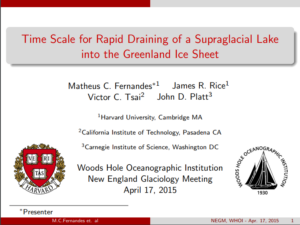Publications - Conference Talks
Publication Types:
Harnessing Design Principles from Glass Sponges for the Production of Structurally Robust Lattices
Abstract
The hexactinellid sponge Euplectella aspergillum (sp.), commonly known as the ”Venus’ flower basket”, has recently attracted increasing attention because of its intricate and regular, cylindrical cage-like structure. This sponge is primarily made of ’brittle silica’ and therefore buckling strength plays crucial role in making it resistant to impacts and environmentally applied stresses. We show through a combination of numerical analysis and experiments that a sponge-inspired double diagonal reinforcement design provides enhanced buckling resistance.
Harnessing Design Principles from Glass Sponges for Structurally Robust Lattices
Abstract
Glass sponges are predominately deep sea sponges that live in ocean depths of 100-2000m. Beyond their fracture propagation inhibiting material composition, these sponges are perceived to exhibit large structural rigidity and strength against buckling. Since these sponges are primarily made of ’brittle silica’, buckling strength may be a crucial property in making them resistant to impact and environmentally applied stresses. Structurally, they exhibit a base square-grid architecture and regular ordering of vertical and horizontal struts that form the skeletal system. Furthermore, their base structure is overlaid with double diagonal reinforcement struts, which create a checkerboard-like pattern of open-closed cell structure. This diagonal reinforcement design is conjectured to give the sponge greater buckling resistance and strength to localized damage then it would experience having a single diagonal reinforcement strut (while allocating the same amount of mass to the diagonal reinforcement.) Analogous to the sponge, many engineering structures, such as buildings and bridges, exhibit diagonal reinforcement struts as a stability mechanism. Based on this similarity, we explore the following research question: Can we generate design principles for diagonal reinforcements of square beam lattices that are optimally designed to avoid global structural buckling? Here, we present a numerical analysis of the structure deformation under various loading conditions as well as survey different arrangements within similar design space of the sponge. Through the various design iterations we look for the critical buckling strain and the elastic load caring capacity. Finally, we compare the results from the sponge design to what is typically used in engineering of structures such as buildings and bridges.
Harnessing Design Principles from Glass Sponges for Engineering Applications
Abstract
Glass sponges are predominately deep sea sponges that live in ocean depths of 100-2000m. Beyond their fracture propagation inhibiting material composition, these sponges are perceived to exhibit large structural rigidity and strength against buckling. Since these sponges are primarily made of ’brittle silica’, buckling strength may be a crucial property in making them resistant to impact and environmentally applied stresses. Structurally, they exhibit a base square-grid architecture and regular ordering of vertical and horizontal struts that form the skeletal system. Furthermore, their base structure is overlaid with double diagonal reinforcement struts, which create a checkerboard-like pattern of open-closed cell structure. This diagonal reinforcement design is conjectured to give the sponge greater buckling resistance and strength to localized damage then it would experience having a single diagonal reinforcement strut (while allocating the same amount of mass to the diagonal reinforcement.) Analogous to the sponge, many engineering structures, such as buildings and bridges, exhibit diagonal reinforcement struts as a stability mechanism. Based on this similarity, we explore the following research question: Can we generate design principles for diagonal reinforcements of square beam lattices that are optimally designed to avoid global structural buckling? Here, we present a numerical analysis of the structure deformation under various loading conditions as well as survey different arrangements within similar design space of the sponge. Through the various design iterations we look for the critical buckling strain and the elastic load carrying capacity. Finally, we compare the results from the sponge design to what is typically used in engineering of structures such as buildings and bridges.

Time Scale for Rapid Drainage of a Surficial Lake into the Greenland Ice Sheet
Abstract
A 2008 report by Das et al. documented the rapid drainage during summer 2006 of a supraglacial lake, of approximately  , into the Greenland ice sheet over a time scale moderately longer than 1 hr. The lake had been instrumented to record the time-dependent fall of water level and the uplift of the ice nearby. Liquid water, denser than ice, was presumed to have descended through the sheet along a crevasse system and spread along the bed as a hydraulic facture. The event led two of the present authors to initiate modeling studies on such natural hydraulic fractures. Building on results of those studies, we attempt to better explain the time evolution of such a drainage event. We find that the estimated time has a strong dependence on how much a pre-existing crack/crevasse system, acting as a feeder channel to the bed, has opened by slow creep prior to the time at which a basal hydraulic fracture nucleates. We quantify the process and identify appropriate parameter ranges, particularly of the average temperature of the ice beneath the lake (important for the slow creep opening of the crevasse). We show that average ice temperatures 5–7
, into the Greenland ice sheet over a time scale moderately longer than 1 hr. The lake had been instrumented to record the time-dependent fall of water level and the uplift of the ice nearby. Liquid water, denser than ice, was presumed to have descended through the sheet along a crevasse system and spread along the bed as a hydraulic facture. The event led two of the present authors to initiate modeling studies on such natural hydraulic fractures. Building on results of those studies, we attempt to better explain the time evolution of such a drainage event. We find that the estimated time has a strong dependence on how much a pre-existing crack/crevasse system, acting as a feeder channel to the bed, has opened by slow creep prior to the time at which a basal hydraulic fracture nucleates. We quantify the process and identify appropriate parameter ranges, particularly of the average temperature of the ice beneath the lake (important for the slow creep opening of the crevasse). We show that average ice temperatures 5–7 below melting allow such rapid drainage on a time scale which agrees well with the 2006 observations.
below melting allow such rapid drainage on a time scale which agrees well with the 2006 observations.

Röthlisberger Channel Model in Ice Stream Shear Margins and Mountain Glaciers Accounting for Anti-plane Shear Loading and Undeforming Bed
Abstract
Ice-stream margins in West Antarctica form from the transition between fast-flowing and stagnant ice. Observations and modelling studies suggest that intense lateral deformation of ice at the margins generates internal meltwater within the ice sheet. Röthlisberger channels (R-channels) may form in which water flows in the downstream direction along the margin. Standard theory argues that the steady-state channel diameter comes from the balance of in-plane creeping and melting rates. However, at the margin, large shear strains acting in the direction parallel to their cross-sectional axis (in the anti-plane direction) can develop. In view of understanding how R-channels evolve within ice streams, we construct a finite-element model (FEM) of an R-channel as considered by Nye (1953) with superimposed anti-plane shear stresses applied along the bed of the ice sheet on the boundary outside of the channel. This is similar to the model presented by Weertman (1972) to describe R-channels formed at the base of mountain glaciers. Weertman’s analysis suggested that the presence of large anti-plane shear stresses, as compared with in-plane stresses, makes the in-plane flow law effectively linear viscous (pseudo-Newtonian). Using our FEM, we examine the limitations of Weertman’s solution as well as when his linear viscous model may be adequate. Furthermore, we examine the effects of shear stresses acting transverse to the channel axis as a result of the interlocking of the bed and the ice. This, as pointed out by Weertman, will change the in-plane solution from being axisymmetric; ultimately making the assumption of a Nye solution near the bed invalid. In addition, we attempt to modify the basal boundary conditions to incorporate the hydrological model proposed by Perol and others (2014), where the basal shear stress varies as a function of the distance from the channel. Ultimately, this makes a comprehensive model for R-channels with anti-plane shear stress hypothesized to exist in ice-stream shear margins and mountain glaciers.
